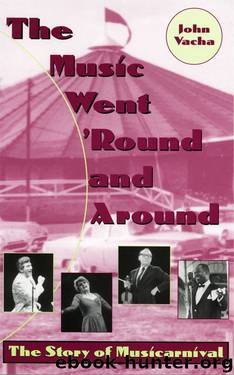The Music Went 'Round and Around: The Story of Musicarnival by John E. Vacha

Author:John E. Vacha
Language: eng
Format: epub
Publisher: Bookmasters Group
All of the above, except The Music Man and The Chocolate Soldier, showed up in the repertoire for the 1960 season. The Music Man followed in 1962 as soon as Musicarnival could get the rights. One of Price’s perennial disappointments was the failure of any Gilbert and Sullivan operetta to break into the top of the list. “I love Gilbert and Sullivan,” he says. “I would have loved to do it, but the audience wasn’t there.” Martyn Green had been there in 1958, and Cleveland thus lost an opportunity to hear him sing one of the patter songs that made him immortal.
Revivals remained frequent during the last of the production years at Musicarnival. South Pacific had been given its fourth showing by 1965; The Student Prince and Show Boat had three apiece. Shows given double exposure in the tent included Kiss Me, Kate; Gentlemen Prefer Blondes; Can-Can; and The Desert Song. But with Vietnam heating up, not even South Pacific was sacred anymore. “We’re particularly cynical about romantic interludes in the midst of war and horror,” demurred Dick Shippy in the Akron Beacon Journal. And in order to bring Romberg’s The Desert Song in tune with the sixties, director Don Driver decided to rework it as a self-conscious travesty of operetta conventions. “Everybody strikes deliberately stilted poses to illustrate how amusingly quaint old operetta singers seemed in acting—were they really so bad?—during that era,” observed Glenn Pullen in the Plain Dealer.
There were also some newcomers during those years—1962 was a very good one for premieres, with Flower Drum Song, Bye Bye Birdie, Gypsy, Fiorello! and Do Re Mi all making their Musicarnival bows. Carnival, Wildcat, and The Unsinkable Molly Brown came in the following summer. The Music Man made its long-awaited debut in 1962 with Monte Amundsen as Marian the librarian and set changes by cast members integrated into the action by director Driver. Two years later Price was finally able to offer the two biggest musicals of their era, The Sound of Music and My Fair Lady. Summing up the latter in the Cleveland Press, Tony Mastroianni observed, “In short, everyone rose to the level of the material, which is a high level indeed.” As for The Sound of Music, it did well enough to merit a revival in the very next season.
One of the freshest new shows of the period was 110 in the Shade, a musical version of N. Richard Nash’s The Rainmaker by Tom Jones and Harvey Schmidt, creators of The Fantasticks. The story of a con man who claims he can bring an end to a searing western drought, 110 in the Shade opened, as luck would have it, on a June night when the Musicarnival tent was hit by a terrific thunderstorm. After a long rain delay, the action happened to resume at the point where the skeptical heroine confronts the self-styled rainmaker with the line, “Well, I bet you feel real pleased with yourself.” It brought the second-biggest laugh of the evening, topped
Download
This site does not store any files on its server. We only index and link to content provided by other sites. Please contact the content providers to delete copyright contents if any and email us, we'll remove relevant links or contents immediately.
The Goal (Off-Campus #4) by Elle Kennedy(13543)
Kathy Andrews Collection by Kathy Andrews(11730)
Diary of a Player by Brad Paisley(7487)
What Does This Button Do? by Bruce Dickinson(6136)
Assassin’s Fate by Robin Hobb(6131)
Big Little Lies by Liane Moriarty(5703)
Altered Sensations by David Pantalony(5046)
Pale Blue Dot by Carl Sagan(4913)
Sticky Fingers by Joe Hagan(4103)
The Death of the Heart by Elizabeth Bowen(3552)
The Heroin Diaries by Nikki Sixx(3496)
Beneath These Shadows by Meghan March(3263)
Confessions of a Video Vixen by Karrine Steffans(3246)
How Music Works by David Byrne(3187)
The Help by Kathryn Stockett(3085)
Jam by Jam (epub)(3025)
Harry Potter 4 - Harry Potter and The Goblet of Fire by J.K.Rowling(2990)
Strange Fascination: David Bowie: The Definitive Story by David Buckley(2801)
Petty: The Biography by Warren Zanes(2697)
